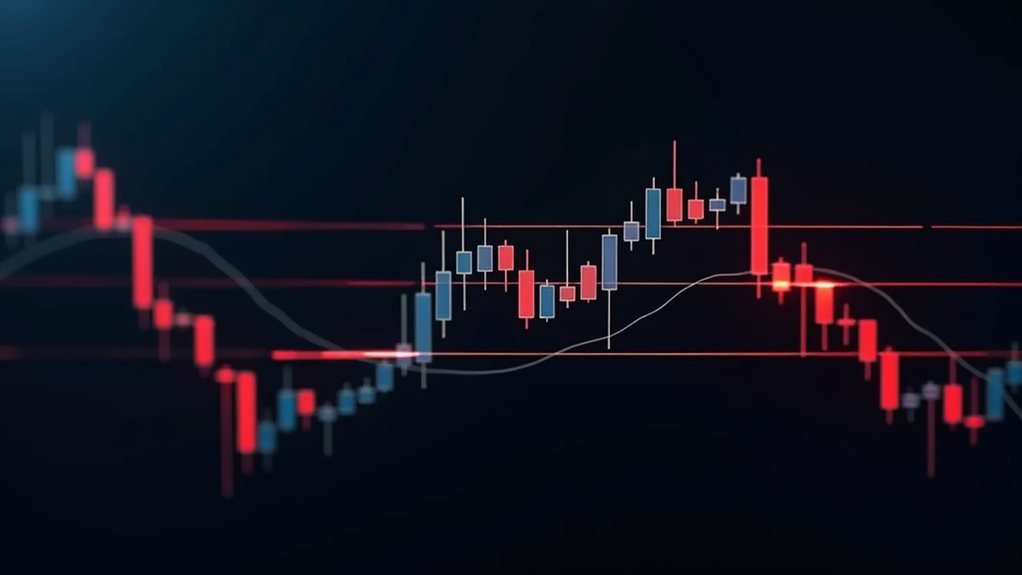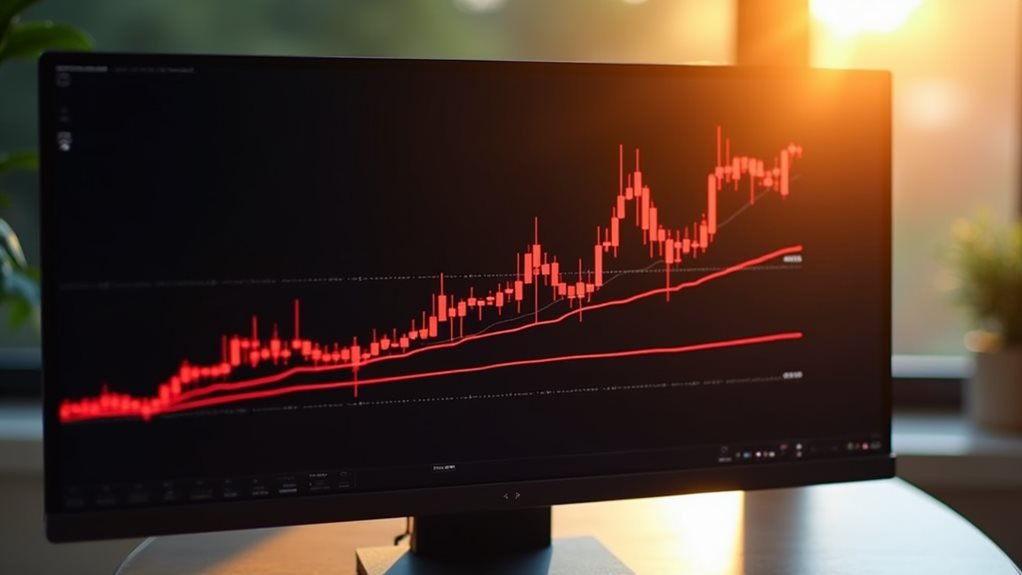I've spent years watching traders struggle with resistance levels, and I'll tell you what most guides won't: these price barriers aren't just lines on a chart – they're psychological battlegrounds where buyers and sellers clash. When I first started trading, I didn't understand why certain price points kept stopping market momentum dead in its tracks. Now I know that mastering resistance levels can mean the difference between consistent profits and painful losses. Let me share what I've learned about spotting and trading these vital market barriers.
Key Takeaways
- Resistance levels are price points where selling pressure increases, causing upward price movements to stall or reverse.
- Historical price charts help identify resistance zones by showing where prices have repeatedly failed to break higher.
- Round numbers and Fibonacci levels commonly act as resistance due to many traders watching these psychological price points.
- Volume increases near resistance levels as more traders actively buy and sell around these important price zones.
- When price breaks through resistance with strong momentum, the old resistance level often becomes a new support level.
Understanding Basic Resistance
Let me be crystal clear: resistance levels aren't magical barriers. They're created by real traders making real decisions with real money. When price approaches these levels, sellers flood in, creating downward pressure. Aerodynamic positioning can provide insights into understanding market dynamics and price movement patterns.
Technical analysis tools like moving averages can help confirm resistance zones. That's why I always tell my students to watch for increased volume at resistance – it's your confirmation that the big players are taking action. Candlestick patterns near resistance areas can provide valuable clues about potential reversals.
Identifying Key Resistance Zones

Spotting key resistance zones requires a systematic approach combining multiple analytical methods. I'll show you how to identify these pivotal areas where price action tends to stall or reverse.
First, dig into historical price data – it's your roadmap to finding where prices have repeatedly hit a ceiling. Trust me, those patterns aren't random. Unfilled gaps on your charts can signal exceptionally strong resistance areas. Air resistance principles can similarly reveal performance patterns in dynamic systems.
Let's get practical. Draw horizontal lines where price has bounced off multiple times – these are your battle-tested resistance zones. Don't ignore round numbers; they're psychological barriers that traders can't help but notice. When crude oil hits $50, everyone's watching. High volume at specific price points often confirms strong resistance levels.
Here's where it gets interesting: Fibonacci retracement levels. I swear by the 38.2%, 50%, and 61.8% levels. They're not magic, but they work because enough traders use them. Your trading software calculates these automatically – use them.
Types of Resistance

Type | Key Characteristics | Best Used For |
| —— | ——————- | ————— |
|---|---|---|
| Horizontal | Static price level, multiple bounces | Day trading, swing trading |
| Trendline | Diagonal line connecting highs | Trend following strategies |
| Dynamic | Moving indicators, constantly updates | Active trading in volatile markets |
Let's get real – horizontal resistance is your bread and butter. It's where price hits a ceiling repeatedly, like a stubborn kid bouncing a ball against the same spot. Stationary bike workouts can help traders maintain focus and mental endurance during trading sessions. Trendline resistance? That's your diagonal barrier, connecting those pesky highs like dots in a downward trend. Dynamic resistance keeps things interesting – it shifts with the market, using indicators like moving averages to stay current. And don't forget psychological resistance – those round numbers where traders get trigger-shy. Think $50, $100, or those Fibonacci levels that seem to work because enough people believe in them. Studying these levels helps traders identify where sellers overpower buyers in the market. Successful traders often combine these resistance types with technical analysis tools for more reliable signals. Master these types, and you'll start seeing the market's architecture in a whole new light.
Trading With Resistance

When it comes to trading with resistance levels, successful execution requires more than just drawing lines on a chart. I'll tell you straight up – you need a systematic approach that combines technical analysis with disciplined strategy. Trust me, I've seen too many traders jump the gun without proper confirmation. Price action trading remains the most reliable method for analyzing market behavior.
Remember that supply and demand dynamics drive the formation and strength of resistance zones. Here's what you'll need to master:
First, identify your resistance levels using multiple timeframes – I'm talking about combining those historical peaks with dynamic indicators like moving averages. Look for at least three touch points to confirm a level's validity. Don't just take my word for it – backtest this yourself.
For breakout trades, I want you to wait for clear momentum beyond the resistance level. Don't be that trader who gets faked out by small price movements. Use price action signals like pin bars or fakey patterns at these levels – they're your bread and butter. And for heaven's sake, always set your stops and limits properly. I can't stress this enough: combine resistance analysis with other technical indicators. One signal's good, but multiple confirmations? That's your sweet spot.
Psychology Behind Resistance Levels

The psychology behind resistance levels shapes every move in the market. I've watched countless traders fall prey to fear and greed at these pivotal points, where human emotions collide with price action. It's fascinating how round numbers like $50 or 1.3000 become psychological barriers – they're nothing special mathematically, but they pack a psychological punch that can stop trends dead in their tracks. The strength of these levels increases dramatically on higher timeframes.
Here's what's really happening: When prices approach resistance, fear kicks in. Traders who bought lower start worrying about losing profits, while potential buyers hesitate to enter at "high" prices. It's pure herd mentality – everyone's watching everyone else, creating a self-fulfilling prophecy. Support and resistance zones help predict where prices might stall or reverse.
I'll tell you something essential: volume spikes near resistance aren't random. They're the footprints of mass psychology at work. Sellers see "overvalued" prices and dump positions. Buyers get cold feet. News events amplify these reactions. But here's the kicker: once resistance breaks, the whole psychology flips.
Yesterday's ceiling becomes today's floor, and that's when things get really interesting.
Frequently Asked Questions
How Often Should Traders Update Their Resistance Levels on Their Charts?
I recommend updating resistance levels daily for short-term trades, weekly for swing trades, and monthly for long-term investments. You'll also want to adjust whenever significant price action occurs.
Can Resistance Levels Predict Exact Price Turning Points With Certainty?
Like a foggy compass, I'll tell you straight: resistance levels can't predict exact turning points with certainty. They're probability indicators that help identify potential reversal areas in price movement.
Do Resistance Levels Work Equally Well Across Different Market Timeframes?
I find resistance levels work differently across timeframes. They're typically more reliable on longer timeframes like weekly and monthly charts, where there's more significant historical price action and market sentiment.
What Percentage of Traders Actually Succeed Using Resistance-Based Trading Strategies?
I'd say the challenging truth is that relatively few traders find lasting success with resistance-based strategies alone. I estimate less than 20% sustain profitable results without incorporating other methods.
How Many Resistance Levels Should a Trader Monitor Simultaneously?
I recommend tracking 3-5 key resistance levels at once. Too many can overwhelm your analysis, while too few might miss important price points that could impact your trades.
